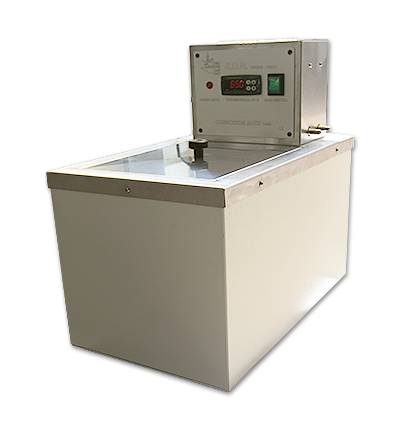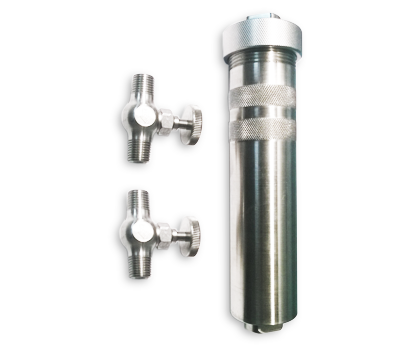ASTM D130
Standard Test Method for Corrosiveness to Copper from Petroleum Products by Copper Strip Test
ASTM D130 is the standard method for the determination of the degree of corrosiveness of petroleum products that exhibit a vapor pressure up to 124kPa (37.8 °C). D130 therefore can be applied to natural, automotive and aviation gasoline, aviation turbine fuel, kerosene, diesel fuel, distillate fuel oil, cleaners’ solvent (Stoddard), lubricant oils and other hydrocarbon fractions falling within the vapor pressure specified limit.
D130 is the only approved method for the assessment of the corrosion potential of petroleum products and streams on equipment and installations of the oil industry.
Corrosiveness is a very important hydrocarbon property that impact both quality of products and the economics of production, transporting and refining operations, yet the quintessential method for its evaluation is subjected to some degree of human biased appreciation…. ”
(Aaron Mendez Ph.D.)
Method Summary:
A polished copper strip is immersed and heated for a period of time in a predetermined volume of the sample being tested. Heated conditions and time of exposure are specific of the class of material described in the scope. After the heating period the strip is removed washed and the degree of corrosiveness of the sample is assessed by visual comparison of the level of tarnish and color against an appropriate ASTM Copper Strip Corrosion Standard.
VISAYA Copper Digital Detection Imaging (CuDDI), improves the visual rating of D130 determining the degree of corrosiveness by digitally and integrally identifying exact levels of corrosion in a 4-step automated vision algorithm and classification process using a high-resolution camera with optical intelligence.
VISAYA CuDDI Test Procedue:
The patent pending NFX Handle is designed to hold your copper strip specimen in the optimal position for viewing within the CuDDI’s optical bench. The handle features an integrated motor and electronics to repetitively and precisely position and rotate the copper specimen.
Properly clean and pat dry the strip prepared according to D130 section 10, utilizing any volatile < 5 mg/kg S solvent provided that it shows no tarnish when tested for 3 hours at 50 °C (122 °F). Isooctane (2,2,4-Trimethylpentane) of 99.75% minimum purity is the referee solvent and should be used in case of dispute.
Hold the NFX Handle with one hand, and use your thumb to press up on the end block towards the adapter plate
While continuing to press down, carefully insert copper strip into bottom block at a slight angle
Position copper strip in line with the top end block, and then release your thumb that is holding the block to secure the block in place
Carefully position the strip to ensure it is straight
Note: Depending on polishing procedures, strip may not be square and therefore may be at a slight angle within the holder. This will not cause any issues, as software accurately determines angles and compensates for this.
Spin handle to ensure proper operation of mechanics
Handle and sample are then ready for normal testing
Insert handle into top opening of CuDDI, taking note to align the gold pins with pins on bulkhead opening.
After placing the handle in the unit and completing all the necessary sample identifiers, CuDDI will automatically run through the following sequence:
- CuDDI connects to the hardware, which includes the Imaging Device and Drive
- CuDDI homes positions to both drive systems to ensure accurate and repeatable positions
- CuDDI moves strip to Position A, which is the first side of the copper strip
- CuDDI then moves to Position B, which is a 180-degree rotation of position A
- For both positions, CuDDI scans the entire strip to develop a high-resolution image of the copper strip
- After positioning and scanning, CuDDI enters into the third phase of the algorithm, which classifies the color ratings using predetermined quadrants.
After successful completion of the test, CuDDI will display the following results and information:
- Images of both sides of strips A & B
- Sample identifiers as entered along with date & time
- Rating along with description and warnings
- Clicking on See more information…” will display:
- Measurement and determination of whether strip dimensions are within tolerance
- Individual ratings for each side
For each side, a user can tap on an image to show a zoom-able image within a pop-out window. To zoom in and out, simply pinch and zoom or, using a mouse and keyboard, hold the Ctrl key to scroll onto the image. This view will also display the tabulated results for each rating as determined by the algorithm. This tabulation is used to logically determine ratings based on a specific set of criteria and weighting system. To exit this view, simply click on the X” at the top right-hand corner.
CuDDI uses a sophisticated algorithm for determining color and ratings of copper strips. In the rare occasion that the user does not agree with the rating, the user is able to click on the Override rating…” button to bring up a familiar looking chart, which can be used to manually select a rating as determined visually. CuDDI will then store this data together with the original automated rating.
Semi-automatic mode is also available to users, this mode allows laboratories that require manual interpretation of results, but still want the convenience of CuDDI’s many features, such as LIMS connectivity and a cross-verification of ratings. If activated in the Settings menu, CuDDI features the ability to prompt the user for the manual external rating prior to CuDDI displaying its automated rating. This works similar to the preceding override function, but selection must be made prior to a run as to not be influenced by CuDDI’s rating.
Similarly, like the fully automated Wizard, which prompts for a sample ID, method, operator and optional description prior to a run, the user is presented with an additional option: simply select the manual rating, which is confirmed by a tap or click. If selected incorrectly, click on a selection until satisfied. Once complete, click the Run button to initiate a run.
CuDDI will then run its analysis using the same method as fully automated mode, however, the display of data will be different. These differences include:
- Rating display box will show the Manual Rating along with the Automated Rating
- Final Rating Selection, which is done by selecting either Manual or Auto
- Override Rating can also be used in this mode.
Operator can select either the Manual or Auto rating as the final rating value.
All pre-loaded Test Methods comply with the ASTM D130 experimental conditions for the different petroleum product classes defined in the scope of the standard method.


